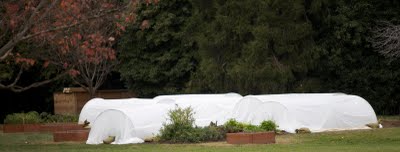Sam Kass: Hoop houses at the White House = Growing veggies through the winter!

Sam Kass has just published a new blog entry on the White House blog, purchase entitled Planting the Winter Garden. It features a video with Sam and Deputy Secretary of Agriculture Kathleen Merrigan talking about hoop houses and cover cropping and of course what is growing in the garden right now.
*Photo by Obama Foodorama
Below is the PRESS RELEASE issued by USDA to coincide with the video release:
USDA Office of Communications
(202) 720-4623
USDA TO LAUNCH HIGH TUNNEL PILOT STUDY TO INCREASE AVAILABILITY OF LOCALLY GROWN FOODS
3-Year Project To Verify Effectiveness Of High Tunnels In Natural Resource Conservation
WASHINGTON, Dec. 16, 2009 – Agriculture Deputy Secretary Kathleen Merrigan today announced a new pilot project under the ‘Know Your Farmer, Know Your Food’ initiative for farmers to establish high tunnels – also known as hoop houses – to increase the availability of locally grown produce in a conservation-friendly way. Merrigan and other Obama administration officials highlighted opportunities available for producers in a video posted on USDA’s YouTube channel at http://www.youtube.com/watch?v=07vtMJgp0no, which shows high tunnels recently installed in the White House garden.
“There is great potential for high tunnels to expand the availability of healthy, locally-grown crops – a win for producers and consumers,” said Merrigan. “This pilot project is going to give us real-world information that farmers all over the country can use to decide if they want to add high tunnels to their operations. We know that these fixtures can help producers extend their growing season and hopefully add to their bottom line.”
The 3-year, 38-state study will verify if high tunnels are effective in reducing pesticide use, keeping vital nutrients in the soil, extending the growing season, increasing yields, and providing other benefits to growers.
Made of ribs of plastic or metal pipe covered with a layer of plastic sheeting, high tunnels are easy to build, maintain and move. High tunnels are used year-round in parts of the country, providing steady incomes to farmers – a significant advantage to owners of small farms, limited-resource farmers and organic producers.
USDA’s Natural Resources Conservation Service (NRCS) will provide financial assistance for the project through the Environmental Quality Incentives Program (EQIP), the EQIP Organic Initiative, and the Agricultural Management Assistance program. NRCS will fund one high tunnel per farm. High tunnels in the study can cover as much as 5 percent of 1 acre.
Participating states and territories are Alabama, Alaska, Arkansas, California, Connecticut, Delaware, Florida, Georgia, Pacific Islands, Illinois, Iowa, Kansas, Louisiana, Maine, Maryland, Massachusetts, Minnesota, Mississippi, Missouri, Montana, Nebraska, Nevada, New Hampshire, New Mexico, New York, North Dakota, Ohio, Oklahoma, Pennsylvania, Rhode Island, South Carolina, South Dakota, Tennessee, Vermont, Washington, West Virginia, Wisconsin, and Wyoming.
To sign up or learn more about EQIP assistance for high tunnel projects, contact a local NRCS office.





